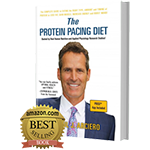Ouch!!! We all know the pain associated with inflammation – it hurts! But, it’s important to understand the different types of inflammation and the effects they have on our body.
Inflammation in our body comes in two forms, acute and chronic. The acute inflammatory process is a natural healing response to intense exercise, an injury, or acute infection. In these cases, local, short-term inflammation usually has a positive effect and leads to enhanced recovery and healing.
However, when inflammation is long-lasting and widespread, it’s usually a sign of poor health. For example, chronic inflammation is associated with a wide number of diseases including, heart disease, diabetes, arthritis, lupus, gastro-intestinal disorders, asthma, Alzheimer’s, autism, Parkinson’s, multiple sclerosis, as well as various other systemic and neurodegenerative conditions. Most inflammatory diseases begin in the gut, so what we eat has a huge impact on either reducing or igniting inflammation throughout the body. In addition, certain musculoskeletal and joint injuries trigger a painful inflammatory response. This is often the case with back and other joint pain.
This may sound surprising, but commonly prescribed medications and drugs are usually not the most effective or safest treatment for many of these inflammatory conditions. These include the family of non-steroidal anti-inflammatory drugs (NSAIDs) (i.e. aspirin, ibuprofen) and narcotic pain-relieving drugs that are often prescribed to reduce the perception of pain and the inflammatory response but often result in serious side effects.
Fortunately, lots of really good scientific evidence is quickly accumulating that shows food compounds in the form of ginger (Ginger), turmeric (Curcumin, Curcumin), omega-3 fats (Fish Oils), pre- and probiotics (pre/probiotics), Capsaicin (Hot Peppers) and tart cherry (Tart Cherries) are effective natural alternatives for reducing pain and inflammation.
Below, I discuss how these foods may be your best defense against both acute and chronic inflammation and promote healing and optimal health. I also provide you detailed instructions on the appropriate amounts you should consume.
-
Ginger
Ginger is used primarily as an alternative analgesic to pharmaceuticals for reducing pain and inflammation. I recommend a daily dose of 1 – 3 g of fresh ginger to reduce joint pain and control blood sugar concentrations by adding it to your morning smoothie (see, Dr. Paul’s PRISE Smoothie) or my Megatabolism Breakfast.
-
Curcumin
Curcumin, a polyphenol responsible for the yellow color of turmeric (curry powder), is another potent anti-inflammatory and positively influences metabolic function. Curcumin improves cardiovascular health, blood sugar control and fat burning, particularly in the abdominal region. Recent research has also shown curcumin to reduce pain associated with exercise-induced delayed-onset-muscle soreness and increase beneficial antioxidant capacity. I recommend you sprinkle curcumin or turmeric on just about any lunch and dinner meal, such as my Buttercup Squash Quinoa recipe to obtain an ideal intake of 90-250 mg daily. Due to the possible low absorption (bioavailability) of curcumin consumed orally they have started producing a higher bioavailable form of curcumin known as Theracurmin®.
-
Omega-3 fatty acids
The main components of omega-3 fatty acids found in fish oil are eicosapentaenoic acid (EPA) and docosahexaenoic acid (DHA). Our body cannot produce these fats so we need to eat them, and for good reason! Both EPA and DHA are known as “eicosanoids” and they have powerful anti-inflammatory effects and reduce pain. As an added bonus, they also drastically enhance heart and brain health and increase lean muscle mass – Wow!
Aim to eat 1-2 grams per day of an EPA:DHA ratio of 2:1, or 2-4 grams per day for those with higher blood lipid profiles, rheumatoid arthritis or intense exercising. For many individuals omega-3 capsule supplementation is most convenient. But, I recommend you get your omega 3’s from whole food sources like, flax and chia seeds, walnuts, sardines, and salmon. If you’re concerned about high levels of mercury in fish, choose: 4.0 oz. Tuna (Canned, Light), 2.0-3.5 oz. of Salmon (Atlantic, wild), 5 oz. of Catfish, and 5.5 oz. of Shrimp (mixed species).
-
Tart Cherry
Tart cherries are a rich source of bioactive compounds with antioxidant and anti-inflammatory effects that reduce pain and aid in recovery from intense exercise. They also contain natural sleep aids so consume before bedtime for a restful night sleep. You need to eat approximately 45 Bing cherries per day so drinking the cherries as juice is the way to go – about 12-16 oz. per day mixed in my smoothie recipe is perfect!
-
Prebiotics and Probiotics
With the rampant rise in gastro-intestinal disorders such as inflammatory bowel disease (ulcerative colitis, Crohns), irritable bowel syndrome, celiac, etc. more and more attention is focused on gut health. There is a clear link between foods we eat and inflammation in our body, most notably is the case with gluten sensitivity. Our gut is also closely linked with our brain health and food has a major effect on this gut-brain highway by altering bacteria levels. Two of the most healthy gut-promoting food sources are derived from fermented milk product with probiotics and prebiotic plant polysaccharides from various carbohydrates such as barley (Benefits of Pre/Probiotics). The dosing for probiotics may be 8-12 oz of fermented yogurt (kefir) or 1 capsule of lactobacillus per day and for prebiotics 2 capsules per day of oligofructose and inulin.
-
Capsaicin (Hot Peppers)
Perhaps the most well-documented natural source of pain-relief is a compound from hot peppers called capsaicin.
Inflammation is a natural event in our body and sometimes it’s beneficial to the healing process. But, when it’s chronic and persistent that’s usually a sign of disease in which case it needs to be stopped. Unfortunately, the treatment is often powerful drugs with even more dangerous side effects. A safer and healthier alternative to prevent and treat inflammation may be found within certain foods and plants. Our best defense to manage inflammation may start by trusting the Power, Healing, and Health Benefits of Food!

